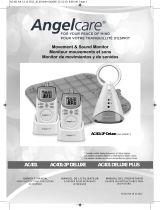TESTING YOUR MONITOR
Always test your monitor before using it the first time and then on a periodic basis. Before
testing your monitor, complete the setup process as described above.
1. Testing for Sound. Turn the Nursery Unit and Parents’ Unit on and be sure the Sound
symbol appears on the Parents’ Unit. Have someone else speak into the Nursery Unit or
place a radio near the Nursery Unit while you take the Parents’ Unit into another room. You
should hear the sounds being transmitted from the Nursery Unit. If there is no sound, adjust
your volume control using the Arrow buttons and/or refer to the Troubleshooting section on
Pg. 18. If you experience interference or static, switch to another channel on the Parents’
Unit. Press the Channel/Select button for two seconds. The Out-of-Range symbol will flash
and the current channel will be displayed. Use the Arrow buttons to choose a different
channel. When the desired channel is displayed, press the Select button again. The Nursery
Unit will automatically switch to the same channel as the Parents’ Unit. The other Parents’
Unit will also automatically switch to the same channel.
2. Testing for Movement. Be sure the Movement symbol appears on the Parents’ Unit. Gently
pat your hand on the mattress. The green Movement Indicator Light on the Nursery Unit will
flash and the Movement symbol on the Parents’ Unit will swing as the Sensor Pad senses
movement. Remove your hand from the mattress. The Movement Indicator Light will stop
flashing, the Movement symbol will stop swinging, and a pre-alarm beep will sound after 15
seconds. Five seconds later (for a total of 20 seconds), the Nursery Unit symbol will appear
on the Parents’ Unit display and the alarm will beep and/or vibrate continuously on both units.
To turn off the alarm on the Parents’ Unit, press the Power button. This will temporarily mute
the Parents’ Unit for two minutes. The Nursery Unit alarm, however, will continue to sound.
To turn off the alarm on the Nursery Unit, turn the unit off and then back on or pat your hand
lightly on the mattress so the Sensor Pad will redetect movement. The units will then revert
to their normal functions. If the Nursery Unit alarm is not turned off, the Parents’ Unit alarm
will reactivate after two minutes. NOTE: If you turn off the Nursery Unit and leave the Parents’
Unit on, the Out-of-Range Indicator will flash and sound if this feature is turned on.
If the alarm does not sound when you are not touching the mattress, the Sensor Pad may
be detecting a continuous vibration from another source from inside and/or outside your
baby’s room. Common sources of this interference are crib mobiles, fans, washing machines,
or even loud music. Therefore, it is very important to make sure all vibration sources are
eliminated before using the monitor. Make sure the Sensor Pad is on a flat, firm surface.
Place the crib near a solid supporting wall and away from strong air currents. Do not use crib
mobiles or accessories that may cause vibrations. Avoid contact with the crib when the
monitor is in use.
If you find the alarm will still not sound when you are not touching the mattress or crib
and you have removed all external sources of vibration, the sensitivity level may need to be
decreased. Please refer to the Movement Sensitivity Adjustment section on Pg. 12.
3. Testing for Battery Power. To verify that all units are operating on battery power, install
batteries into the units. The Parents’ Units should operate when they are removed from the
Charging Bases (after the initial 15-hour charge) and the LCDs should be lit. The Nursery
Unit should operate when the AC adapter is unplugged and the green Power Indicator
should light up.
11


























